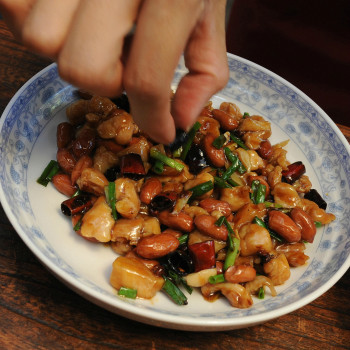This week, the Lunar New Year was celebrated by millions around the world, many of them in Southern California, where there’s a huge Asian diaspora population. In the L.A. suburb known as the San Gabriel Valley, a densely-concentrated Chinese community has birthed a cluster of restaurants which many food critics consider among the best Chinese food outside China. Of course, there is no single ‘Chinese food’ — the vast country produces many regional cuisines — and lately it’s Sichuan cooking in particular that has diners in the U.S. lining up for a taste.
While that region’s signature dishes have a reputation for oily, spicy boldness, when Rico sat down for a meal with food writer and Chinese-cuisine expert Clarissa Wei at Alhambra, CA restaurant Szechuan Impression, he learned the food is more subtle and refined than many Westerners think.

Rico Gagliano: First off, why for so long was Cantonese-style Chinese cooking the standard in America?
Clarissa Wei: Definitely immigration patterns. The first people who came over here, for the railroads, they were from Taishan — which is an area in rural Guangdong — the Cantonese region. So, that’s why there was a lot of Cantonese-style food. But now there is an influx of mainland Chinese people coming from all over China.
Rico Gagliano: Do you think that’s why Sichuan keeps getting better and more popular, because more from that area are coming here?
Clarissa Wei: Yeah, and Sichuan is also one of the more popular schools of Chinese cooking. The capital of Sichuan, which is Chengdu — they were the only city in China to have been awarded a UNESCO-site award for gastronomy, and that’s given out by the United Nations.
Rico Gagliano: Because it’s so awesome?
Clarissa Wei: Yeah, because it’s so awesome! And because there’s a lot of tradition. We’ll se,e when we eat the food, a lot of cool things like tea-smoking. They tea-smoke duck or they tea-smoke ribs.
The chef here, if you talk to him, he’ll say Sichuan cooking is all about the feel. You can’t write it in a recipe.It’s a very ingrained tradition.
Rico Gagliano: I think the Sichuan dish that people are most familiar with is probably kung pao chicken. Is that a real thing in authentic Sichuan cuisine, or is that some Americanization?
Clarissa Wei: Yeah. There is a dish called gong bao ji ding, which is basically kung pao chicken, but it tastes completely different from what you’re probably used to. I feel like a lot of the Americanized Chinese restaurants, they put a lot of corn starch, so it’s gloppy. And they think people really like sugar, so they add a lot of sugar. Sichuan cooking is not like that. It’s not sweet. It’s mostly focusing on garlic and spiciness.
 Rico Gagliano: The spiciness, from what I’ve read about Sichuan cooking, seems to come to the fore. And there’s a special Sichuan pepper that has kind of special properties. Tell us about it.
Rico Gagliano: The spiciness, from what I’ve read about Sichuan cooking, seems to come to the fore. And there’s a special Sichuan pepper that has kind of special properties. Tell us about it.
Clarissa Wei: So, that’s the hu jiao. It’s a dried peppercorn. And it’s actually not a pepper, it’s in the citrus family — so it’s more closely related to a lemon than a pepper. The flavor is called ma la, that means ‘numbing’. So, if you get a big enough whiff of it, it will numb your tongue.
They have two different types of peppercorns here. They have a red peppercorn and they have a green peppercorn. The green is much more acidic and lemon-y, if you will.
Rico Gagliano: How is it different — the way one’s tongue is numbed in this cuisine — as opposed to, say, if I take a big bite of super-hot Tabasco or something?
Clarissa Wei: The sensation is, if you drink cold water, your entire mouth will buzz a little bit.
Rico Gagliano: After you eat this food?
Clarissa Wei: After you eat this. But, Szechuan Impression, they do it very subtly, so it’s not like, “Oh, I dare you to go eat Szechuan Impression.” There are places where you can do that, you know? Force your friend to eat a platter of chicken with the peppercorn. But, here, it’s a lot more refined. Although they have french fries sprinkled with peppercorn — that’s pretty intense.
Rico Gagliano: Let’s go inside and check this out.
Clarissa Wei: Yay!
Rico Gagliano: All right, our food as arrived. At least, some of it.
Clarissa Wei: So, I’ll talk a little bit about this soup. It’s called tao jiao. This is actually a more modern dish, and the story is that there was an herbal medicine doctor, and he decided to cobble together this kind of herbal broth. And so many people lined up in front of his place to eat it that they were sitting cross-legged in front of the restaurant. Which is why it’s called “cross-legged beef soup.” And if you look at the soup, it’s really herbal… There’s daikon in it… and tripe and beef… and then, right next to it, is the spices, so you can customize your spice level.
Rico Gagliano: And then there’s a big pile of kidney, which has been chopped up, and that’s got the green peppercorn on it?
Clarissa Wei: Yeah.
Rico Gagliano: And it’s going to not burn my face off?
Clarissa Wei: Let me try, actually. [tasting it] Oh, wow. It won’t burn your face off. It’s really subtle.
Rico Gagliano: Okay. I’m going to go for it. [tasting it] It is surprisingly delicate. It’s almost got a tofu quality to it.
Clarissa Wei: Yeah, it kind of tastes like tofu. And if you wait a little bit, you will taste that citrus-y thing on your tongue, on the tip of your tongue.
Rico Gagliano: You’re right — I was just going to say that as you were saying that! It’s amazing, the aftertaste. It’s tingly, but in a really pleasant way. Almost menthol-like.
Clarissa Wei:
You know you’re in a good Sichuan restaurant when the flavors are subtle and they don’t overwhelm you at first bite. They will creep up on you.
Rico Gagliano: But this is kind of incredible, the after-burn on this pepper. It’s just lasting and lasting on my tongue. It’s not painful or anything, but it just doesn’t want to go away.
Clarissa Wei: Yeah, and the more cold stuff you drink, the more intense it will get. So, try drinking that and see what happens.
Rico Gagliano: All right — I’m going to take a drink of plum juice. [tastes it] That kind of kicked it up a notch, but the plum juice, actually, is deliciously smoky. It’s made from smoked plum. So it’s actually counter-balancing the citrusy-ness.
Clarissa Wei: Yeah, which is why rmolecular gastronomy trends, I roll my eyes at. Because Chinese food already has all of these cool properties. When you eat a peppercorn you’ll feel numbing… and then you have this smoky plum, which does another thing to your mouth… So, it’s like a science experiment.
Rico Gagliano: Without any liquid nitrogen or anything.
Clarissa Wei: Yeah.


